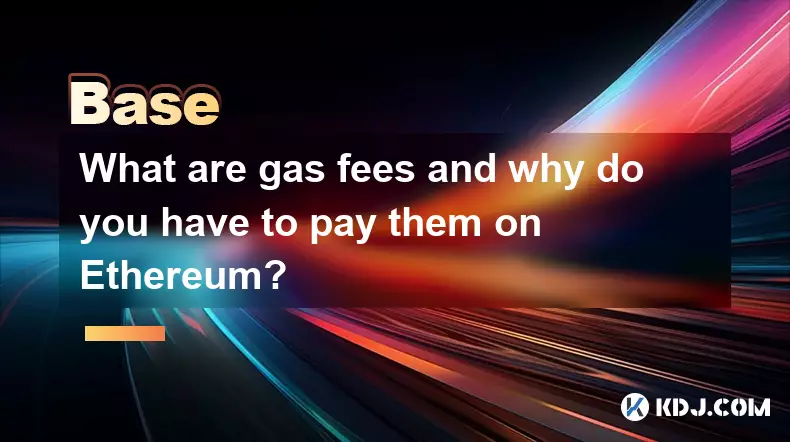-
 bitcoin
bitcoin $105968.894684 USD
4.17% -
 ethereum
ethereum $3639.320047 USD
7.62% -
 tether
tether $1.000339 USD
0.06% -
 xrp
xrp $2.407774 USD
5.96% -
 bnb
bnb $1011.704193 USD
2.28% -
 solana
solana $166.942754 USD
6.37% -
 usd-coin
usd-coin $1.000143 USD
0.03% -
 tron
tron $0.291515 USD
0.25% -
 dogecoin
dogecoin $0.181682 USD
4.06% -
 cardano
cardano $0.585450 USD
4.54% -
 hyperliquid
hyperliquid $42.099968 USD
5.20% -
 chainlink
chainlink $16.160745 USD
5.45% -
 zcash
zcash $645.269648 USD
12.96% -
 bitcoin-cash
bitcoin-cash $507.430338 USD
2.80% -
 stellar
stellar $0.290357 USD
3.69%
What are gas fees and why do you have to pay them on Ethereum?
Gas fees on Ethereum compensate validators for computational work, prevent spam, and ensure network efficiency, with costs varying based on demand and transaction complexity.
Nov 07, 2025 at 02:59 pm

Understanding Gas Fees in the Ethereum Network
1. Gas fees are payments made by users to compensate for the computational energy required to process and validate transactions on the Ethereum blockchain. Every action, whether sending ETH, interacting with a smart contract, or minting an NFT, consumes a certain amount of gas. This system ensures that network resources are used efficiently and prevents spam.
2. The concept of gas is unique to Ethereum and similar blockchains. It acts as a unit measuring how much computational effort a transaction or operation requires. Simple transfers require less gas, while complex smart contract executions demand more. Each operation has a predefined gas cost set by the Ethereum protocol.
3. Users must pay gas fees because the Ethereum network relies on decentralized nodes and miners (or validators in Proof-of-Stake) to execute and confirm transactions. These participants dedicate hardware, electricity, and time to maintain the network. Gas fees serve as an incentive for them to prioritize and process user operations.
4. Without gas fees, malicious actors could flood the network with infinite loops or spam transactions, rendering the system unusable. The fee mechanism introduces a cost to computation, making such attacks economically unfeasible and preserving network stability.
5. Gas fees fluctuate based on network congestion. During periods of high demand—such as during popular NFT mints or DeFi launches—the competition to have transactions included in the next block drives up prices. Users can choose to pay higher fees to speed up confirmation times.
The Role of Ether in Gas Payments
1. Although gas is measured in units, it is paid in ETH, Ethereum’s native cryptocurrency. When you initiate a transaction, you specify a gas limit (the maximum amount of gas you’re willing to use) and a gas price (how much ETH you’ll pay per unit of gas). The total fee is calculated as gas limit multiplied by gas price.
2. For example, if a transaction requires 21,000 units of gas and the gas price is 20 gwei (1 gwei = 0.000000001 ETH), the total cost would be 0.00042 ETH. Any unused gas is refunded to the sender, but overestimating doesn’t cost extra beyond the actual consumption.
3. The gas price is denominated in gwei to allow for micro-payments. Wallets often suggest gas prices based on current network conditions, helping users balance between cost and speed.
4. After the transition to Proof-of-Stake, part of the gas fees is burned—permanently removed from circulation—through EIP-1559. This deflationary mechanism reduces the total supply of ETH over time, potentially increasing its scarcity and value.
5. Paying gas fees in ETH ensures alignment across the ecosystem: developers optimize code for efficiency, users consider transaction necessity, and validators receive compensation for securing the network.
How Gas Fees Impact User Experience
1. High gas fees can deter new users and limit access to decentralized applications, especially during peak times. Transactions that cost several dollars may not be feasible for small transfers or experimental interactions.
2. Developers design dApps to minimize gas usage, employing techniques like batch processing, off-chain computations, and layer-2 solutions. Efficient coding directly affects usability and adoption rates.
3. Layer-2 networks such as Optimism, Arbitrum, and zkSync alleviate gas costs by handling transactions off the main Ethereum chain and settling batches on-chain. These solutions offer near-instant confirmations at a fraction of the cost.
4. Despite fluctuations, gas fees remain essential for maintaining Ethereum’s security model and preventing resource abuse. They reflect real economic trade-offs within a decentralized environment.
5. Wallet interfaces now provide detailed breakdowns of estimated fees, allowing users to adjust parameters manually. Advanced options let experienced users set custom gas limits and prices depending on urgency and budget.
Frequently Asked Questions
What happens if I set a very low gas price?
If the gas price is too low, miners or validators may ignore your transaction due to lack of incentive. It could remain pending for hours or get dropped entirely. Most wallets warn users when the selected fee is below recommended levels.
Can gas fees be completely eliminated?
No, gas fees cannot be fully eliminated without compromising network integrity. However, scaling solutions and protocol upgrades aim to reduce their impact. Zero-gas models exist on some sidechains but sacrifice decentralization or security.
Why do simple token swaps sometimes cost more than ETH transfers?
Swapping tokens involves executing smart contracts, which perform multiple operations like approvals, balance checks, and price calculations. Each step consumes gas, making the overall cost significantly higher than a basic ETH transfer.
Is there a way to get refunds for failed transactions?
Gas fees are not refunded for failed transactions because computational work was still performed by the network. However, only the gas used up to the point of failure is charged; any remaining gas within the limit is returned.
Disclaimer:info@kdj.com
The information provided is not trading advice. kdj.com does not assume any responsibility for any investments made based on the information provided in this article. Cryptocurrencies are highly volatile and it is highly recommended that you invest with caution after thorough research!
If you believe that the content used on this website infringes your copyright, please contact us immediately (info@kdj.com) and we will delete it promptly.
- Altcoins, BlackRock, and a Bitcoin-Bullish Future: What's the Play?
- 2025-11-10 20:50:01
- Bitcoin Gains and Market Moves: What's Happening?
- 2025-11-10 20:35:01
- Zcash Price Prediction: Will the ZEC Breakout Continue?
- 2025-11-10 18:45:01
- XRP Price, AlphaPepe, and Predictions: What's the Buzz?
- 2025-11-10 18:55:01
- Crypto Explode: News Insights for Savvy Investors
- 2025-11-10 19:10:01
- XRP Price Rockets Amid ETF Buzz, Zcash Mimics Moonshot: A Breakdown
- 2025-11-10 19:10:01
Related knowledge

What is the difference between a transparent and a shielded transaction?
Nov 10,2025 at 05:59pm
Understanding Transparent Transactions in Cryptocurrency1. Transparent transactions are the standard form of transaction on most public blockchains li...

What is a "crypto airdrop farmer" and what strategies do they use?
Nov 09,2025 at 03:39pm
What Is a Crypto Airdrop Farmer?1. A crypto airdrop farmer is an individual who actively participates in blockchain projects to qualify for free token...

How does a crypto insurance protocol work?
Nov 08,2025 at 12:39am
Understanding Crypto Insurance Protocols1. A crypto insurance protocol operates by offering financial protection against losses incurred from digital ...

What is token composability and why is it called "DeFi Legos"?
Nov 09,2025 at 06:39am
Bitcoin's Role in Decentralized Finance1. Bitcoin remains the cornerstone of decentralized finance, serving as a benchmark for value and trustlessness...

What is an "exploit" versus a "hack" in the context of smart contracts?
Nov 09,2025 at 12:40am
Understanding Exploits in Smart Contracts1. An exploit refers to the utilization of a known vulnerability within a smart contract’s code to gain unint...

What is a decentralized storage network and how does it compare to cloud services?
Nov 07,2025 at 11:59pm
Understanding Decentralized Storage Networks1. A decentralized storage network distributes data across a peer-to-peer infrastructure rather than relyi...

What is the difference between a transparent and a shielded transaction?
Nov 10,2025 at 05:59pm
Understanding Transparent Transactions in Cryptocurrency1. Transparent transactions are the standard form of transaction on most public blockchains li...

What is a "crypto airdrop farmer" and what strategies do they use?
Nov 09,2025 at 03:39pm
What Is a Crypto Airdrop Farmer?1. A crypto airdrop farmer is an individual who actively participates in blockchain projects to qualify for free token...

How does a crypto insurance protocol work?
Nov 08,2025 at 12:39am
Understanding Crypto Insurance Protocols1. A crypto insurance protocol operates by offering financial protection against losses incurred from digital ...

What is token composability and why is it called "DeFi Legos"?
Nov 09,2025 at 06:39am
Bitcoin's Role in Decentralized Finance1. Bitcoin remains the cornerstone of decentralized finance, serving as a benchmark for value and trustlessness...

What is an "exploit" versus a "hack" in the context of smart contracts?
Nov 09,2025 at 12:40am
Understanding Exploits in Smart Contracts1. An exploit refers to the utilization of a known vulnerability within a smart contract’s code to gain unint...

What is a decentralized storage network and how does it compare to cloud services?
Nov 07,2025 at 11:59pm
Understanding Decentralized Storage Networks1. A decentralized storage network distributes data across a peer-to-peer infrastructure rather than relyi...
See all articles























![🔥 Long awaited! The ancestor of Pi coin is about to take off? PI friends, come in and take a look! [Daily Coin Selection | Bitcoin Trend | Money Making Opportunities] 🔥 Long awaited! The ancestor of Pi coin is about to take off? PI friends, come in and take a look! [Daily Coin Selection | Bitcoin Trend | Money Making Opportunities]](/uploads/2025/11/10/cryptocurrencies-news/videos/6911e42f9bad7_image_500_375.webp)


















































